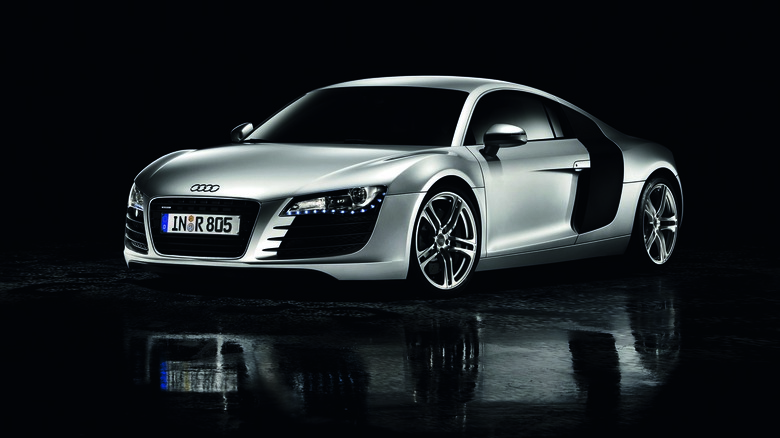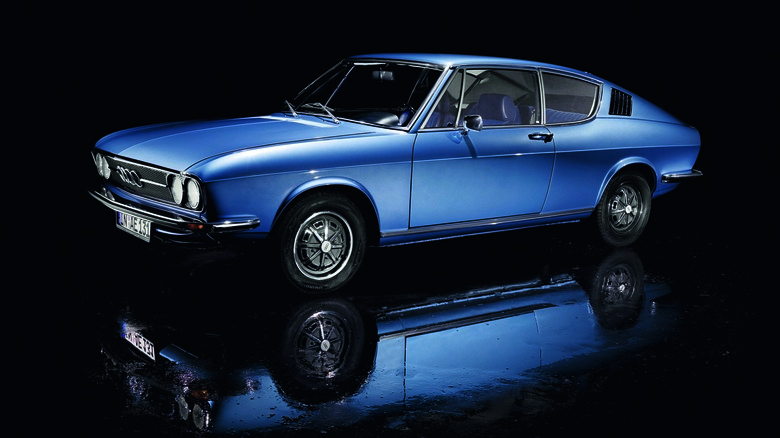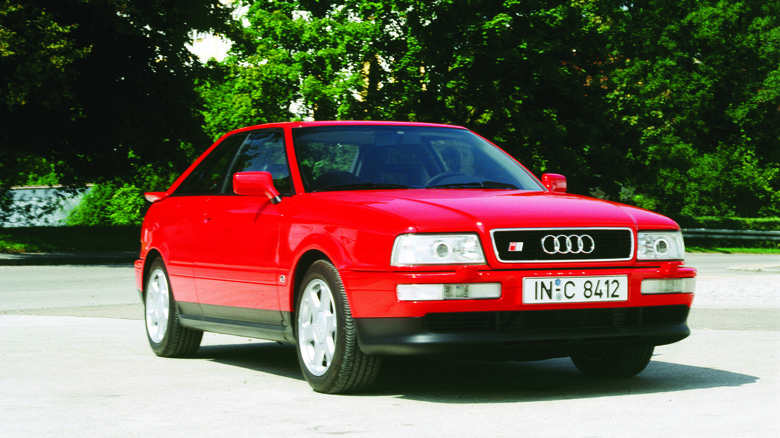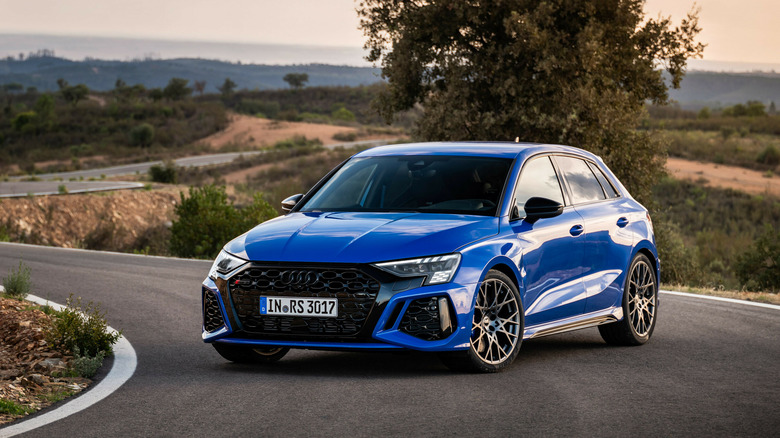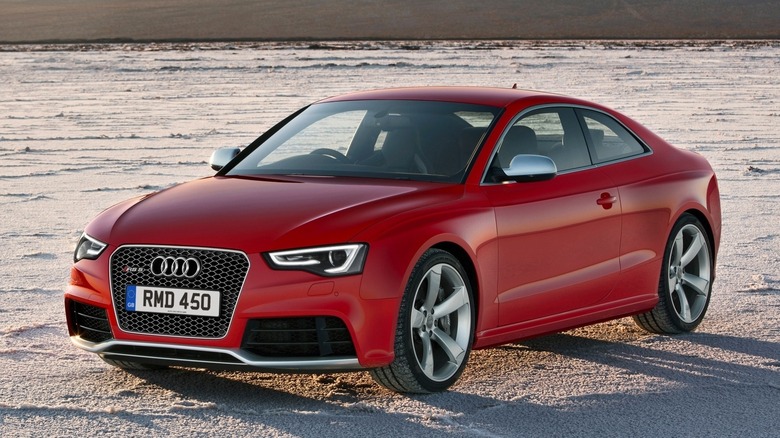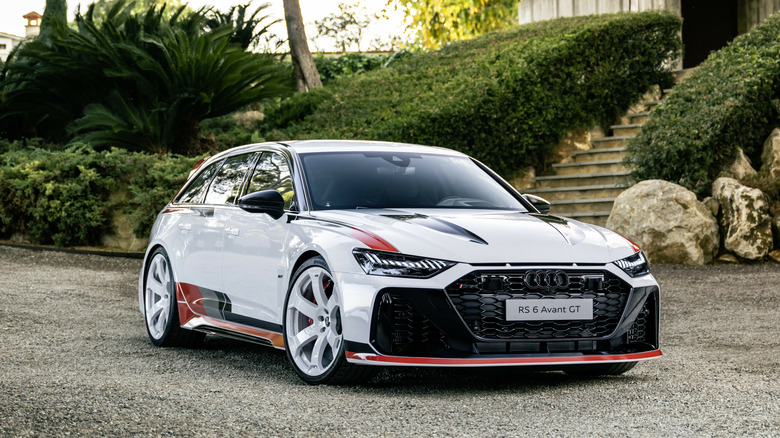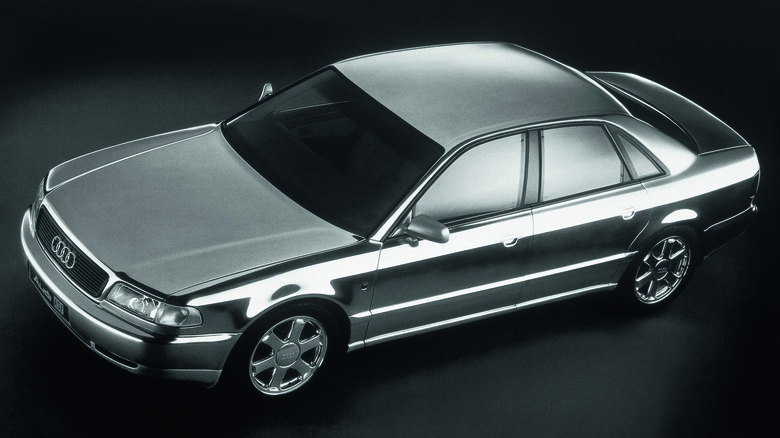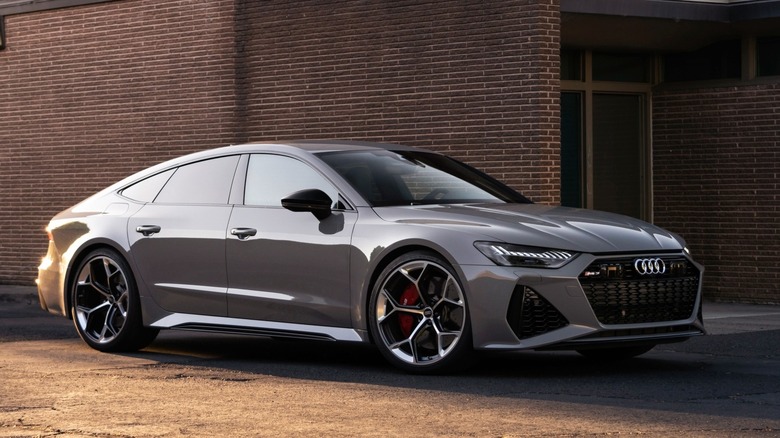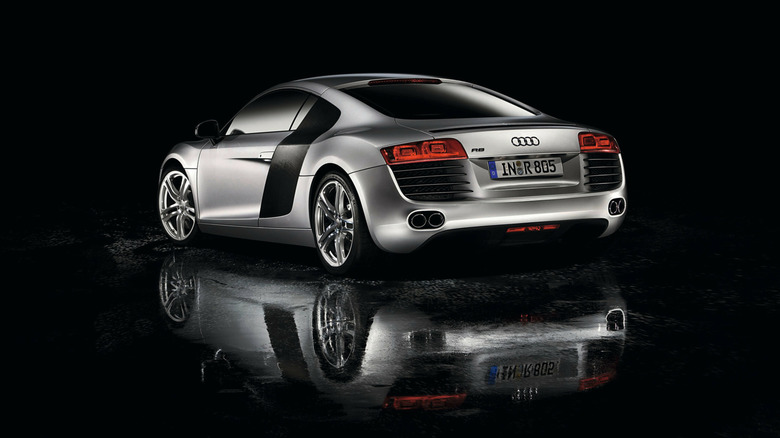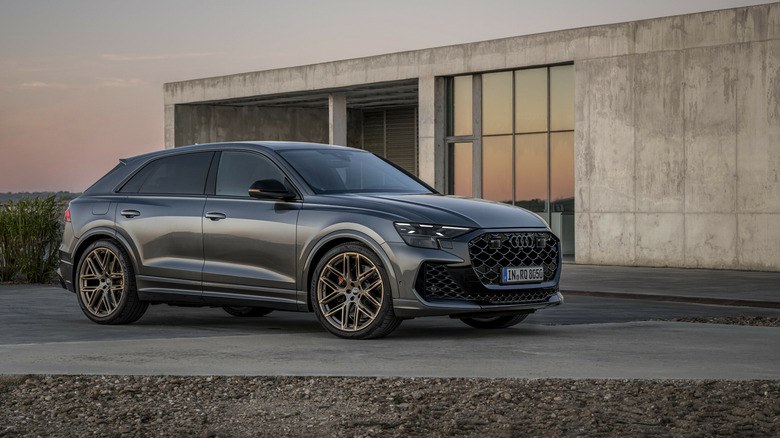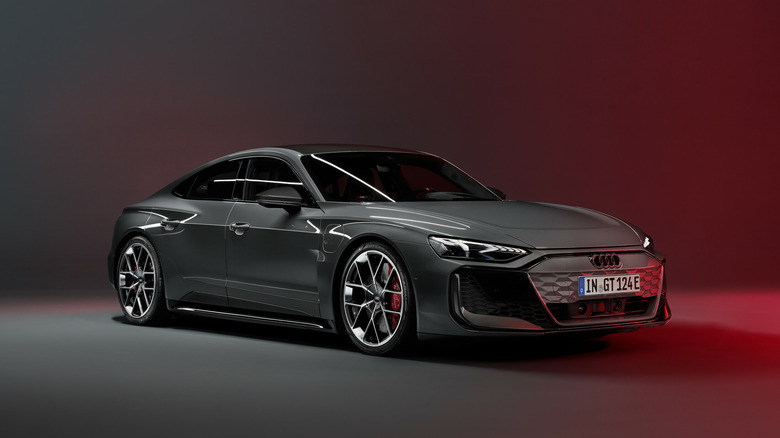10 Of The Best Looking Audi Models Ever Designed
Audi might not be the first automaker to come to mind when debating automotive design with car people. The Ingolstadt-based automaker has created a very successful design language, with its vehicles being recognizable from quite a distance, but it's never exactly been a trendsetter. Some feel its cars are understated and too minimalistic, though others prefer that approach. Whatever your feeling toward its "Russian doll" design sensibilities, the company certainly sells a lot of vehicles every year.
Samey aesthetic criticisms aside, Audi's designers have actually created quite a few models that left a mark on automotive design. These cars followed the general Audi aesthetic but still pushed the boundaries with bolder details or altered proportions. They are "objectively beautiful," if there is such a thing existing in this world, and most people will probably like their designs. At least, that's our view on the matter. So, with the risk of provoking a few souls, here is our list of 10 of the best looking Audi models in the brand's history!
Audi 100 Coupé S (1970 to 1976)
Is that an Audi muscle car? It sure looks like one, doesn't it? The fastback rear end with cooling fins on the C pillar and the keen front end with four circular headlights that connect masterfully to the Audi logo leaves quite the impression. The 100 Coupé was one of Audi's first sports cars for the general audience, launched in 1969. The "S" model we are looking at here is the fastback version, which looks miles better than the regular Coupé.
However, the 100 Coupé S hides a secret. Its front overhangs and cooling fins in the back might lead you to believe it's an RWD muscle car, but it isn't. Audi did some tricks to hide the fact that the 100 Coupé S is actually a front-wheel-drive vehicle, like placing the front radiator sideways. It definitely worked — put the 100 Coupé S next to any American muscle car of the era, and it will blend perfectly.
Still, you won't be getting the performance or sound of classic muscle cars from the 1970s. Under the bonnet, this Audi hides a paltry 1.9-liter four-pot, producing a meager 112-115 hp. Buyers could either have it with a four-speed manual or a three-speed automatic, with the former giving you a 0-60 mph time of 9.7 seconds and a top speed of 114 mph. Far from impressive, especially when you consider that the 100 Coupé S was very expensive when new. Unsurprisingly, Audi sold only 30,600 models.
Audi S2 Coupé (1990 to 1996)
The S2 Coupé does not look like a muscle car, but unlike the 100 Coupé S, it drives like one. Well, at least in an Audi sort of way. Although not very well-known among enthusiasts, the S2 Coupé is an Audi performance car through and through, packing the brand's Quattro AWD system with a 2.2-liter turbocharged inline-five engine. Depending on the model year, you either get 220 hp (five-speed manual) or 230 hp (six-speed manual), resulting in a 0-62 mph time of 5.7 seconds and a top speed of 154 mph.
There is also something evergreen about the S2 Coupé's body design. It's understated by today's standards, without the flashy add-ons like LED lights or body kits. Still, the simplicity works in S2 Coupé's favor. Every line and detail here is nicely integrated, and everything works together in symphony. The rear spoiler, for example, announces that this is no regular Audi, but it does that quite delicately. The compact proportions further accentuate the sportiness of the S2 Coupé.
Although it's a well-performing and good-looking sports coupe, the S2 wasn't a sales success. You can blame its predecessor, the Sport Quattro, for that, which was a much more intense sports car, packing a 2.1-liter turbocharged inline-five with 306 hp. The predecessor was much lighter, too, tipping the scales at 2,862 pounds vs. 3,130 pounds. Even so, the S2 Coupé remains one of the most underrated German sports cars, and it definitely deserves more attention.
Audi RS 3 Sportback (2021 to Present)
Audi finally corrected its mistake of launching a less powerful successor to the Sport Quattro with the first-gen RS 3 Sportback in 2011. With its 2.5-liter turbocharged inline-five producing 340 hp, Quattro AWD system, and compact dimensions, the RS 3 was the true spiritual successor to the rally legend. Aided by the seven-speed dual-clutch automatic, the RS 3 could accelerate to 60 mph in around 4 seconds!
Today's RS 3 Sportback is wackier still, as its 2.5-liter unit produces 400 hp and 369 lb-ft of torque, resulting in a 0-62 mph time of 3.8 seconds. It's hugely impressive in other areas, too, providing outstanding grip in the corners, thanks to its Quattro AWD system with an "RS torque splitter," which can send 50% of the available torque to each of the rear wheels. Let's also not forget the sweet-sounding inline-five engine, which has a much more pleasing note than any of its four-cylinder rivals.
Audi did an impressive job with the styling, too. There is still some of the simplicity of the brand's sports cars of yore, but the RS 3 looks much more audacious, particularly in the front. The grille is huge and menacing but blacked out, so it doesn't dominate the front end. Moreover, the headlights are integrated into the grille, and nicely accentuated by the cooling vents below. The Sportback (hatchback), in particular, looks very sharp from the rear, too, with the stylized side profile connecting the dots perfectly.
Audi RS 5 Coupé Facelift (2012 to 2015)
It's rare that facelifted models look better. Maybe it's because the car was never intended to look like that or because designers were forced to change something just for the sake of it. However, the facelifted first-gen RS 5 Coupé flipped the script when it launched in 2012. The original RS 5 Coupé was already a cool-looking vehicle, but the 2012 RS 5 took things up a notch by further smoothing out its lines.
Notably, the smaller LED headlights accentuate the grille even further but also create more negative space, which gives the 2012 RS 5 Coupé a less-crowded look. Even so, the large air intake make sure it maintains enough aggression — this is the high-performance RS 5 model, after all. Take a quarter turn around the 2012 RS 5 Coupé, and you'll see a perfect representation of Audi's mastery of creating a muscular side profile that makes it look like the car is carved from one piece. The rear fastback rear end finishes everything off with nicely designed taillights and two huge exhaust tips integrated into the bumper.
However, the design is only a part of the story here. The RS 5 Coupé's 4.2-liter naturally aspirated V8 engine produces an angry sound that will make you think again about buying the car with its twin-turbo V6. Even without forced induction, the V8 is good for 450 hp and 317 lb-ft of torque, translating into a 0-60 mph time of 4 seconds!
Audi RS 6 Avant (2019 to Present)
Wagons have always had a reputation for being boring, but the latest Audi RS 6 Avant looks better than most sedans, with its slab-like side profile, hi-tech, aggressive front end, and fastback-like rear end. This is particularly true for the 2025 RS 6 Avant GT model that borrowed the livery from the legendary Audi 90 Quattro IMSA racer. This latest iteration has a more keen, less busy front end, gorgeous white wheels, and just the right amount of sportiness.
Still, that's not to say the pre-facelift model looks bad. The 2021 RS 6 Avant we tested is already a very handsome wagon and also one that's incredibly well put together. It's great when you are not looking at it, too, with its 591-hp 4.0-liter twin-turbo V8 delivering blistering performance and the Quattro AWD system providing excellent cornering agility. We also liked the interior, and let's not forget the wagon part — the RS 6 Avant is a hugely practical vehicle.
Still, the 2025 RS 6 Avant Performance takes things up a notch. Audi massaged its engine to 621 hp and 627 lb-ft of torque, resulting in a 0-60 mph sprint of just 3.3 seconds. Meanwhile, the GT model with the IMSA livery also receives a special differential on the rear axle and adjustable coilovers for even sharper handling. It sits a whole inch closer to the ground, too, which is probably the main reason why it looks so damn good.
Audi A8/S8 D2 (1994 to 2003)
Audi shocked the world by dominating motorsports with its Quattro AWD system, emerging as a direct competitor to Mercedes-Benz and BMW in the luxury car segment. However, in order to compete at the highest level, Audi needed a car that would rival the S-Class and 7 Series, so the A8 D2 was born. This groundbreaking luxury sedan set a few firsts for the industry.
Introduced in 1994, the first-gen Audi A8 was the world's first production car with a chassis and body made from aluminum. The "Audi Space Frame" chassis weighed 40% less than a steel chassis would have while offering similar stiffness. As a result, Audi could negate the weight penalty of the Quattro drivetrain, which was standard on the more powerful models like the S8.
The first S8 packed a 4.2-liter V8 with 360 hp and 317 lb-ft of torque, and reached 62 mph in 5.4 seconds. Not only that, but it remained relatively lightweight at 3,814 pounds — not bad considering its size and AWD system. The best part is that it came with a six-speed manual transmission, something you don't see in any modern luxury barge. This was truly Audi's first high-performance luxury sedan.
The design was very understated, without too much visual drama, but that worked in its favor. The car's imposing dimensions were enough to make it stand out — no need to go overboard with the styling. The simple yet elegant lines still gave the A8/S8 D2 a fresh look.
Audi A7/RS 7 (2018 to Present)
The Audi A7 was born in a similar way to the A8. The car was designed to compete with the recent onslaught of four-door coupes from Mercedes-Benz and Porsche — the CLS and Panamera. While the super-stylish first generation coupe succeeded in delivering an alluring charm, in our eyes the second-gen A8 is where Audi unleashed its design prowess.
This is especially true in the RS 7 variant, which has the right level of aggressiveness while remaining classically handsome. Notably, the proportions of the RS 7 are just right — it's long, wide, and low to the ground. Furthermore, thanks to the lower jawline than other Audis, the RS 7 has a smaller grille; it's still imposing but definitely doesn't dominate the look. instead, the grille works in symphony with the headlights and side vents, creating a perfect beginning for the rest of the body. In true Audi fashion, the side profile is expertly sculpted, while the rear end is sleek and futuristic, emphasizing the performance credentials of the RS 7.
And, as colleague Chris Davies discovered when driving the 2024 RS 7 Performance, it's quite a performant car. Upfront, it packs a 4.0-liter twin-turbo V8 producing 621 horsepower and 627 lb-ft of torque, enough for a brisk 0-60 mph time of 3.3 seconds, but it feels even quicker than that. The V8 sounds glorious, too, while the air suspension takes care of both comfort and handling. Still, it's not surprising for a car with such a hefty price tag.
Audi R8 (2007 to 2015)
All Audi cars since the R8 were based on a front-wheel-drive platform, with the engine sitting ahead of the front axle. Audi did that to place the engine longitudinally and allow its Quattro AWD system to shine. However, this approach created some handling headaches, like more understeer than on a comparable RWD car from BMW, Mercedes-Benz, or Jaguar.
So, when Audi decided to create a halo car that would trump its competitors, only a mid-engine configuration would have worked. Unlike most mid-engine supercars, though, the R8 came standard with Quattro AWD, keeping it in line with every other performance vehicle from the brand. It was a sign that Audi was ready to compete at the highest level, rivaling brands like Porsche, Ferrari, and Lamborghini.
Like the first-gen A8, the R8 was an aluminum monocoque construction for higher rigidity and lower weight. In the middle, it had a 414-hp 4.2-liter V8, later upgraded to a 525-hp 5.2-liter V10, both naturally aspirated. It even had a gated manual transmission for some classic Ferrari vibes. Thanks to its mid-engine layout, the R8 was much more agile than any Audi before, while the Quattro AWD system gave drivers outstanding grip in the corners.
And then there is the design. With a cab-forward design, the R8 looks ready to attack at any moment. The large front grille and nicely stylized headlights add to its aggressiveness, while the side profile is muscular. Every detail seems to work in symphony, perhaps even more successfully than the current-gen R8, which is a great-looking car on its own.
Audi RS Q8 (2020 to Present)
The BMW X6 started a small revolution in the automotive industry with its coupe-like silhouette and high clearance. The general public loved the idea, though people with keener eyes were not so fond of the weird proportions. You either love or hate the BMW X6, but the opposite is true for Audi's Q8. Instead of copying BMW, like Mercedes-Benz did with its GLE Coupe, Audi went in the opposite direction with the sporty version of its large Q7 SUV.
The Q8 still has a more sloped rear end that adds dynamics to the overall look, but it does not have the extended lower part of the X6 and GLE Coupe. The hatchback-like design looks more cohesive, and, dare we say, it is even more muscular. And the rest of the body connects the dots perfectly. Notably, the expertly sculpted side profile with haunches over the wheels gives it a road presence and visually shortens the huge SUV, while the front end has that mildly imposing look.
The highest-performing RS Q8 model turns everything up to 11 in the styling department and is one of the finest-looking SUVs currently on sale. Its huge road presence might be revolting to some, but there is no denying Audi did a fine job designing its high-riding flagship. You also can't dispute its performance; with a 631-hp 4.0-liter twin-turbo V8 (Performance model) and electromechanical active roll stabilization, the RS Q8 is quick in a straight line and agile in the corners.
Audi RS e-tron GT (2021 to Present)
The e-tron SUV has initiated Audi's EV voyage, but it's the e-tron GT that fascinated enthusiasts and made them believers in electricity. From the fashionable proportions to the high-performing electric powertrain, the e-tron GT has everything it needs to compete at the highest level. Except for range, that is, which, at around 230 miles, falls significantly short of its rivals.
You will turn more heads per battery charge than most other EVs, though. The e-tron GT, particularly in the high-performance RS guise, looks just stunning. The EV platform allowed Audi to push its design language to the limit — the short overhands, long wheelbase, and wide/low profile create an eye-catching stance that looks even better in person than in the pictures. Furthermore, the subtly aggressive front end, masterfully sculpted side lines, and coupe-like rear end with striking LED taillights add to the visual drama.
The RS e-tron GT is blazing fast, too. With 637 hp in over-boost mode, courtesy of two electric motors on each axle, in our testing, this handsome four-door coupe reached 60 mph in 3.09 seconds. Like any other EV, it's also easy to launch, giving you traffic-light-winning launches every single time. Moreover, despite weighing 5,115 pounds, the RS e-tron GT is agile and delicate through the corners. It will get even better soon, with the recently-announced 2025 RS e-tron GT Performance packing a 912-hp powertrain (with over-boost), enabling it a 0-62 mph time of 2.5 seconds. If only it sounded like the R8 V10 Plus!
